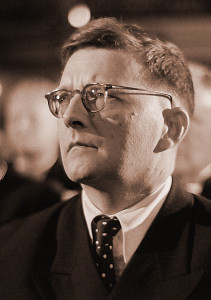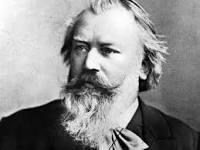The San Francisco Symphony performed the Shostakovich Violin Concerto No. 1, in A minor, Opus 77(99) and the Brahms Symphony No. 4 in E minor, Opus 98, October 5, at the Davies Symphony Hall. This listener is still standing to applaud it was such great music performed majestically. Music Director, Esa-Pekka Salonen, conducted with strength and understanding of masterpieces of two great composers
 Dmitri Shostakovich, composer (1906 – 1975)
Dmitri Shostakovich, composer (1906 – 1975)
From the very first sound from the violin, my whole being straightened up in attention to the exquisite music made by one draw of bow across instrument. Sayaka Shoji, the soloist, plays the “Recamier” Stradivarius violin, ca. 1729, loaned to her by Ueno Fine Chemicals Industry, Ltd. The violin may have been played by other outstanding musicians, but I believe it had been waiting four centuries for its ideal partner, Ms Shoji. Shostakovich made this concerto a marathon challenge for the violinist. She performs continuously. She must run a rocky path and up a steep mountain, something like climbing Half Dome. There is a small sign requiring the violinist to meditate; she climbs high enough to bring the music to stillness but never to a stop. There are moments she shares with a flute and a clarinet both supporting her pilgrimage. If you love Shostakovich’s music, and I do, this is a profound message. It is alive with the philosophical melody of the first movement, Nocturne. The Scherzo contains the composer’s laughs at a dictator’s cruelty. Folk dance is suggested, but it is not for jolly folk. It is rough and creepy. The third movement, Passacaglia, blossoms into nine variations led by the horns and more wind instruments. Their wind blows through each variation turning into a funeral call. Ms Shoji’s cadenza has a wild sadness and brings more of the folk dance back onto the stage as though the energetic dancers are crazed by loss. From the cadenza the music pours into rousing bagpipe sounds and a non-stop party of all the musicians, folks, and roaming strangers, a revel of jumping, running, and celebrating joy in this moment.
 Johannes Brahms, composer, (1833 – 1897)
Johannes Brahms, composer, (1833 – 1897)
Brahms. The long wait for him to produce his first symphony is a familiar story. He terrorized himself thinking of Beethoven following him, intimidating his writing. He began making notes and sketches in 1850, but the tremendous, glorious Symphony No. 1 debuted in 1876. His Symphony No. 4 was a triumph and the last of his symphonies. The performance by SF Symphony, October 5, led by Esa-Pekka Salonen, affected the listener’s heart while emotion was spoken by beautiful, quiet, lyrical passages, Allegro non troppo. Behind the first movement, and behind each movement, there is always something that cannot be named: a texture, interactions of instruments, a thought for the world. Brahms was a great intellect as well as a great musician. His writing found ways to allow us to hear the music with all our attention and yet be aware that there is something we will never see. In his writing, he broke some classical ways. In the program’s essay,, the late, wonderful writer Michael Steinberg explains how a seemingly small step changed every thing. “Almost everyone was upset over what appears now one of the most wonderful strokes in the work, the place where Brahms seems to make the conventional, classical repeat of the exposition but changes one chord after eight measures, thereby opening undreamed-of harmonic horizons….” This must be what a master of the technique as well as of the sound can do. “One small step” could change everything. Then, it is like breathing, something also easy, complicated, and brilliant. Brahms mines the Baroque and Renaissance music for something new, inspired by Bach’s Cantata No. 150. He did not try to do “authentic” ancient music; he discovered how he could understand it and then do it but differently. The entire symphony is full of energy even when the music is quiet. Passion drives the music, but it never colors outside the lines. Great and true passion lets us learn many possibilities and unifies the world.